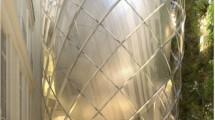Abstract
The case study presented is a 195 meters tall office tower with a raised podium made of full height glass panels, up to 15 meters high. The panels are only restrained by prestressed high-strength stainless-steel rods, lying entirely in the glass panel build-up, composed by four 12 mm thick plies, laminated with 1.52 mm thick sheets of ionoplast interlayer, with an overall thickness of approx. 52 mm. Due to the facade geometry and the high wind expected, movement joints between rods are introduced, allowing for differential movements to avoid peak stresses in the glass panels. Also, smooth transition between rod rectangular section at the interface with the glass panels to circular section at anchor points need to be ensured by CNC machining to avoid failure of the rod anchors due to fatigue. Sophisticated non-linear 3D FEM models had to be analyzed to predict glass stresses, differential movements to be accommodated by the joints and geometrical transition between rod sections. The main innovation of this facade was the use of prestressed rods in conjunction with jumbo size glass panels. As tension structures experience large movements, it was crucial to understand the effect of these deformations imposed by the rods onto the full height glass panels, analyzing steel and glass members together as a single facade entity. Furthermore, in contrast to typical cable wall facade where the prestressed elements (cables) are offset from the glass line, here the rods are located in the plane of the glass panels and completely flush with them, ensuring the thinnest possible build-up in relation to the large facade span. A rocking portal frame, moving together with the rods to avoid excessive warping in the glass panels, has been used as a solution to deal with the required opening in the facade. An additional complication was given by the high wind load (typhoon) applied on the facade which required rods’ prestress in the order of 1000 Kilonewton to limit glass stresses and deflections.






























Similar content being viewed by others
References
BS EN 1993-1-11. Eurocode 3 – Design of steel structures. Design of structure with tension components, (2006)
BMT. Taikoo Place Podium Cable Glass Wall Wind Loading Study (2018)
Code of Practice for the Structural Use of Glass, Building Department, Hong Kong, (2018)
Code of Practice for Structural Use of Steel, Building Department, Hong Kong, (2011)
Code of Practice on Wind Effects, Building Department, Hong Kong, (2004)
Strand7. User Manual – Release 2.3, (2005)
Acknowledgements
The Author would like to thank Swire Properties for the opportunity and the privilege given to lead the engineering design of such a challenging and ambitious project; the NBBJ team in Seattle / Hong Kong / Los Angeles, for their amazing ideas and great collaboration and teamwork. The Author would also like to show his gratitude to OAP Hong Kong, as Engineers of Record, for their support throughout the intense path of the HK Building Department approval, and to G & M Engineering for their dedication and constant effort during these first months of construction phase. Last but not least, the Author would like to thank all the people involved in this project throughout the design stages - colleagues but also manufacturers - for their incredible support and continuous help and advice.
Author information
Authors and Affiliations
Corresponding author
Ethics declarations
Conflict of interest
The author states that there is no conflict of interest.
Additional information
Publisher's Note
Springer Nature remains neutral with regard to jurisdictional claims in published maps and institutional affiliations.
Rights and permissions
About this article
Cite this article
De Mari, G. Large deflection glass facade in typhoon area: Taikoo Place 2 podium wall. Glass Struct Eng 6, 309–330 (2021). https://doi.org/10.1007/s40940-020-00137-3
Received:
Accepted:
Published:
Issue Date:
DOI: https://doi.org/10.1007/s40940-020-00137-3




